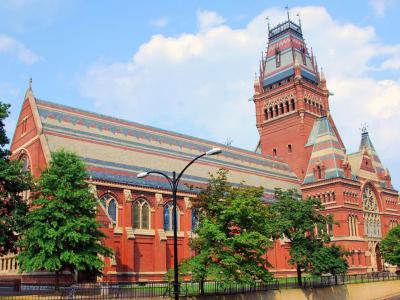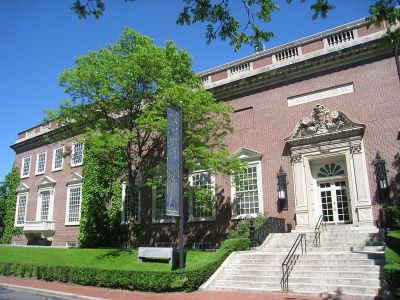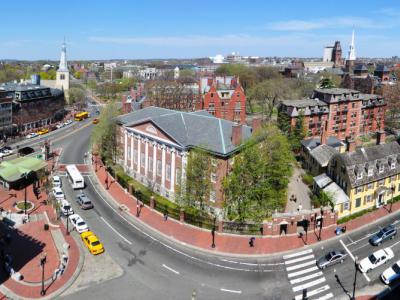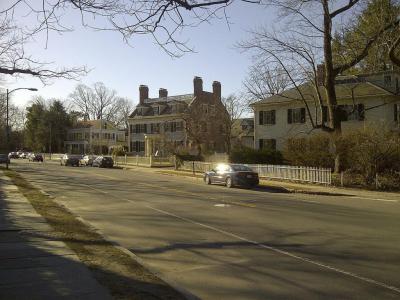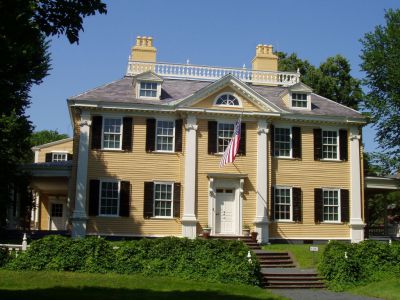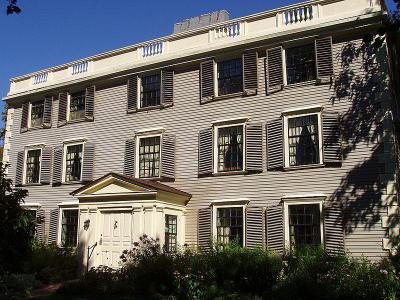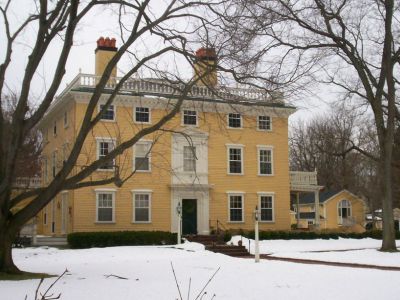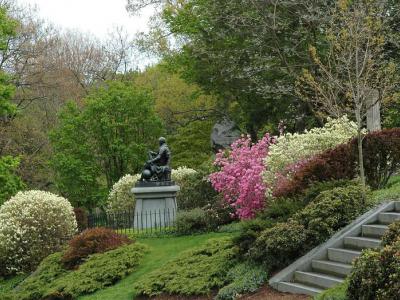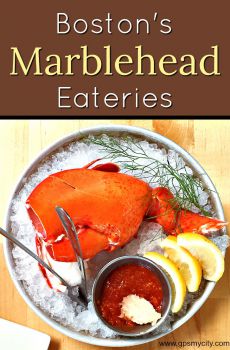Historical Cambridge MA Walking Tour (Self Guided), Boston
Once a quiet New England farming village-turned capital of the Massachusetts Bay Colony, today's Cambridge, MA is a university town that dazzles visitors as the home of renowned Harvard University – alma mater of many intellectuals, literary geniuses, celebrities, and wealthy and powerful. Many of America’s elite have spent some time at Harvard, and their contributions to Cambridge have left a lasting imprint.
The town itself is a mishmash of historical haunts, student hang-outs, alternative art and culture venues, vintage clothing shops, bookstores and ethnic restaurants – in a few words, really cool.
Start at the immense Memorial Hall rising just outside of the Harvard Yard. An impressive architectural wonder, its main attraction is the Sanders Theatre, mostly open during concerts and other events. The nearby Fogg Museum recently underwent an extensive renewal, resulting in a magnificently lighted and curated space. While there are other excellent museums in Boston, this one must not be missed.
Continue with Harvard Square, a hub of activity and mixture of trendy stores, outdoor cafes and colorful local characters. From there, the route will take you past many important historic buildings lining Brattle Street, and finally land you at the Mount Auburn Cemetery – a great place to escape the big city while still getting amazing views of its Downtown.
To explore these and other facets of Cambridge's past and present, follow our self-guided walking tour.
The town itself is a mishmash of historical haunts, student hang-outs, alternative art and culture venues, vintage clothing shops, bookstores and ethnic restaurants – in a few words, really cool.
Start at the immense Memorial Hall rising just outside of the Harvard Yard. An impressive architectural wonder, its main attraction is the Sanders Theatre, mostly open during concerts and other events. The nearby Fogg Museum recently underwent an extensive renewal, resulting in a magnificently lighted and curated space. While there are other excellent museums in Boston, this one must not be missed.
Continue with Harvard Square, a hub of activity and mixture of trendy stores, outdoor cafes and colorful local characters. From there, the route will take you past many important historic buildings lining Brattle Street, and finally land you at the Mount Auburn Cemetery – a great place to escape the big city while still getting amazing views of its Downtown.
To explore these and other facets of Cambridge's past and present, follow our self-guided walking tour.
How it works: Download the app "GPSmyCity: Walks in 1K+ Cities" from Apple App Store or Google Play Store to your mobile phone or tablet. The app turns your mobile device into a personal tour guide and its built-in GPS navigation functions guide you from one tour stop to next. The app works offline, so no data plan is needed when traveling abroad.
Historical Cambridge MA Walking Tour Map
Guide Name: Historical Cambridge MA Walking Tour
Guide Location: USA » Boston (See other walking tours in Boston)
Guide Type: Self-guided Walking Tour (Sightseeing)
# of Attractions: 8
Tour Duration: 2 Hour(s)
Travel Distance: 3.5 Km or 2.2 Miles
Author: anna
Sight(s) Featured in This Guide:
Guide Location: USA » Boston (See other walking tours in Boston)
Guide Type: Self-guided Walking Tour (Sightseeing)
# of Attractions: 8
Tour Duration: 2 Hour(s)
Travel Distance: 3.5 Km or 2.2 Miles
Author: anna
Sight(s) Featured in This Guide:
- Memorial Hall / Sanders Theatre
- Harvard Art Museums
- Harvard Square
- Brattle Street
- Longfellow House - Washington's Headquarters National Historic Site
- Hooper-Lee-Nichols House
- Elmwood House
- Mount Auburn Cemetery
1) Memorial Hall / Sanders Theatre
One of Harvard's most ancient structures, erected in 1878 as a tribute to the alumni who fought and perished in the Civil War, Memorial Hall boasts nifty pointed arches and flying buttresses. Although its appearance resembles that of a church, complete with a central vaulted narthex illuminated by filtered sunlight streaming through Tiffany and La Farge stained-glass windows, the space actually functions as Sanders Theatre, undeniably Harvard's most impressive venue for concerts. Renowned for its wooden paneling and exceptional acoustics, it hosts year-round classical music performances by local choirs and ensembles, along with occasional concerts featuring jazz and world musicians.
Memorial Hall itself is a circular chamber enclosed by towering columns made of Siena marble, where the original flags carried by Massachusetts soldiers into battle are on display behind transparent panels, and it is illuminated by a vaulted stained-glass window bearing the state seal. On the third floor, suspended above the public gallery in the House of Representatives, hangs a carved wooden fish known as the Sacred Cod, dating back to 1783. This symbol of maritime prosperity is taken so seriously by politicians that, in the 1930s, when Harvard pranksters swiped it, the House refused to convene until it was recovered.
In close proximity, Annenberg Hall, a spacious area primarily used as a dining hall, is decked out with portraits and sculptures of big-shot alumni, basically serving as a motivational hall of fame for all the overachievers at Harvard.
Memorial Hall itself is a circular chamber enclosed by towering columns made of Siena marble, where the original flags carried by Massachusetts soldiers into battle are on display behind transparent panels, and it is illuminated by a vaulted stained-glass window bearing the state seal. On the third floor, suspended above the public gallery in the House of Representatives, hangs a carved wooden fish known as the Sacred Cod, dating back to 1783. This symbol of maritime prosperity is taken so seriously by politicians that, in the 1930s, when Harvard pranksters swiped it, the House refused to convene until it was recovered.
In close proximity, Annenberg Hall, a spacious area primarily used as a dining hall, is decked out with portraits and sculptures of big-shot alumni, basically serving as a motivational hall of fame for all the overachievers at Harvard.
2) Harvard Art Museums
Harvard University's oldest museum, which houses the combined collections of the Busch-Reisinger, Fogg, and Arthur M. Sackler Museums, achieved this merger in late 2014, and the three museums now exist under a splendid, predominantly glass roof. Designed by the acclaimed architect Renzo Piano, the complex spans 204,000 square feet across seven levels, enabling a more comprehensive display of Harvard's extensive 250,000-piece art collection, featuring European and American art spanning from the Middle Ages to present days.
Notable highlights encompass American and European paintings, sculptures, and decorative arts from the Fogg Museum; Asian art, Buddhist cave-temple sculptures, and Chinese bronzes from the Arthur M. Sackler collection; as well as works by German expressionists, materials associated with the Bauhaus, and postwar contemporary art from German-speaking Europe from the Busch-Reisinger Museum.
While retaining the Fogg's central courtyard, designed in the style of a 16th-century Italian Renaissance facade, as its nucleus, the complex extends both upward and outward. Within the courtyard, one can find the admissions desk, a small café, and a gift shop.
Tip:
Exploring the complex is best done from the top down. A recommended starting point is the Lightbox Gallery on Level 5, where visitors can engage with digital projects and delve into the collection. Looking down into the courtyard offers a view of Renzo Piano's ingenious architectural expansion, all while affording an overhead perspective of the expansive Alexander Calder mobile that fills the space. Visitors also have the opportunity to peek into the laboratories of the Straus Center for Conservation and Technical Studies.
Notable highlights encompass American and European paintings, sculptures, and decorative arts from the Fogg Museum; Asian art, Buddhist cave-temple sculptures, and Chinese bronzes from the Arthur M. Sackler collection; as well as works by German expressionists, materials associated with the Bauhaus, and postwar contemporary art from German-speaking Europe from the Busch-Reisinger Museum.
While retaining the Fogg's central courtyard, designed in the style of a 16th-century Italian Renaissance facade, as its nucleus, the complex extends both upward and outward. Within the courtyard, one can find the admissions desk, a small café, and a gift shop.
Tip:
Exploring the complex is best done from the top down. A recommended starting point is the Lightbox Gallery on Level 5, where visitors can engage with digital projects and delve into the collection. Looking down into the courtyard offers a view of Renzo Piano's ingenious architectural expansion, all while affording an overhead perspective of the expansive Alexander Calder mobile that fills the space. Visitors also have the opportunity to peek into the laboratories of the Straus Center for Conservation and Technical Studies.
3) Harvard Square
Cambridge is kind of like a giant bow tie, with Harvard Square smack in the middle, forming the knot. Harvard University sprawls out from here, and together, they form the brainy and cultural heart of Cambridge. It's where folks flock to check out the famous Ivy League school, soak in some history, savor the lively coffeehouse-and-bookstore scene and a dash of rebellious counterculture. Even though it's just a square mile in size, it's jam-packed with things to do and see, making it a part of town you don't want to skip.
The action mostly goes down in an area known as "The Pit", which is a hub for teens to hang out, flaunt their vibrant green hair, and show off their latest body piercings. It's also the beginning of the street music scene, where talented performers like folk sensation Tracy Chapman and country star Bonnie Raitt got their big breaks. If you're looking for some square-time excitement, aim for Friday and Saturday nights or Sunday afternoons when the place is buzzing – crowds, street performers, and good vibes galore.
When it comes to food, Harvard Square has you covered with an array of restaurants dishing out global flavors. Japanese, American, Italian, Middle Eastern, Korean – you name it, they've got it. If the weather's playing nice, snag a seat in a beer garden or take to the streetside. For a unique experience, check out Daedalus, a spot fashioned from a greenhouse, complete with a heated rooftop bar where you can chill year-round. If ramen's your jam, Hokkaido Ramen at No. 1 Bow Street has communal tables for your noodle feasting pleasure.
Feeling artsy? Catch some indie flicks or top-notch plays at the arthouse theaters around. And hey, if you're up for a mental challenge, they've got outdoor chess sets that see plenty of action.
Tip:
Take a peek at the calendar – you might strike gold and find yourself in Harvard Square during a festival. Winter Carnival, Chinese New Year, Mayfair, and Sparklefest – they all add a little extra sparkle to the seasons.
The action mostly goes down in an area known as "The Pit", which is a hub for teens to hang out, flaunt their vibrant green hair, and show off their latest body piercings. It's also the beginning of the street music scene, where talented performers like folk sensation Tracy Chapman and country star Bonnie Raitt got their big breaks. If you're looking for some square-time excitement, aim for Friday and Saturday nights or Sunday afternoons when the place is buzzing – crowds, street performers, and good vibes galore.
When it comes to food, Harvard Square has you covered with an array of restaurants dishing out global flavors. Japanese, American, Italian, Middle Eastern, Korean – you name it, they've got it. If the weather's playing nice, snag a seat in a beer garden or take to the streetside. For a unique experience, check out Daedalus, a spot fashioned from a greenhouse, complete with a heated rooftop bar where you can chill year-round. If ramen's your jam, Hokkaido Ramen at No. 1 Bow Street has communal tables for your noodle feasting pleasure.
Feeling artsy? Catch some indie flicks or top-notch plays at the arthouse theaters around. And hey, if you're up for a mental challenge, they've got outdoor chess sets that see plenty of action.
Tip:
Take a peek at the calendar – you might strike gold and find yourself in Harvard Square during a festival. Winter Carnival, Chinese New Year, Mayfair, and Sparklefest – they all add a little extra sparkle to the seasons.
4) Brattle Street
Known initially as the King's Highway and then Tory Row – ahead of the American Revolutionary War, Brattle Street in Cambridge, MA has been one of the most prestigious residential streets in the United Stated for over two centuries. Today, the street is a home to many historic buildings, ranging from the modernist glass-and-concrete edifice that once housed the Design Research store to a Georgian mansion where George Washington and the poet Henry Wadsworth Longfellow both resided (albeit at different times). Centuries later, Robert Lowell, another American poet, also made his home on Brattle Street.
In 1775, George Washington settled on Brattle Street, establishing his army headquarters in the abandoned mansions of seven wealthy loyalists, all of which have managed to survive the test of time. In 1913, Samuel Atkins Eliot described the seven Colonial mansions of Brattle Street's 'Tory Row' as "...not only one of the most beautiful but also one of the most historic streets in America. As a fashionable address, it is doubtful if any other residential street in this country has enjoyed such long and uninterrupted prestige."
Laden with stories of Puritanical trials, British Loyalists, and poetic talent mixed with beautiful architecture and well-manicured green space, over the centuries, Brattle Street has the given the world – courtesy of its residents – baking powder, Fig Newtons, Polaroid cameras, and Sadie Hawkins Day. Quite a remarkable leagacy for just one street!
Tip:
At No. 44, Harvest's kitchen has witnessed the culinary artistry of some of the world's finest chefs over its four-decade-long reign as the pinnacle of dining in Harvard Square. Don't miss the locale's rear patio, offering the finest al fresco dining experience in the neighborhood.
In 1775, George Washington settled on Brattle Street, establishing his army headquarters in the abandoned mansions of seven wealthy loyalists, all of which have managed to survive the test of time. In 1913, Samuel Atkins Eliot described the seven Colonial mansions of Brattle Street's 'Tory Row' as "...not only one of the most beautiful but also one of the most historic streets in America. As a fashionable address, it is doubtful if any other residential street in this country has enjoyed such long and uninterrupted prestige."
Laden with stories of Puritanical trials, British Loyalists, and poetic talent mixed with beautiful architecture and well-manicured green space, over the centuries, Brattle Street has the given the world – courtesy of its residents – baking powder, Fig Newtons, Polaroid cameras, and Sadie Hawkins Day. Quite a remarkable leagacy for just one street!
Tip:
At No. 44, Harvest's kitchen has witnessed the culinary artistry of some of the world's finest chefs over its four-decade-long reign as the pinnacle of dining in Harvard Square. Don't miss the locale's rear patio, offering the finest al fresco dining experience in the neighborhood.
5) Longfellow House - Washington's Headquarters National Historic Site
This Brattle Street house, like many in its vicinity, was constructed by Colonial-era merchants loyal to the British Crown during the Revolution. When the original owner fled back to Europe, American revolutionaries seized the property, and it served as George Washington's headquarters during the long Siege of Boston, from July 1775 to April 1776.
The renowned poet Henry Wadsworth Longfellow resided here in 1837, received the house as a wedding gift in 1843, and called it home until his passing in 1882. It was within these walls that he penned his most celebrated poems, including "Tales of a Wayside Inn" and "The Song of Hiawatha". The first floor remains perfectly preserved from his time, complete with his personal belongings, including his writing desk and papers, making it feel as though the poet had just been working on a poem.
While tours of the house are mainly offered during summer months, you can enjoy the grounds and the formal garden year-round. The garden is a true gem, nestled far enough from bustling Brattle Street to provide a peaceful escape. On sunny spring Sundays, you'll experience unparalleled serenity as you sit in the shade of the pergola, savoring the fragrance of lilacs, blooming ornamental fruit trees, or roses, all while listening to the distant church bells of Cambridge. A 2006 restoration faithfully recreated the garden's original design and color palette, introducing 1,700 tiny Korean boxwoods to replicate the low hedges that Longfellow himself had laid out.
Alas, the imposing tree with a canopy on the side lawn is a linden, not the spreading chestnut celebrated in Longfellow's famous poem about the village blacksmith. When that original tree had to be removed, local schoolchildren raised funds to craft a chair from its wood, which they presented to the poet. Today, that chair still occupies a place of honor in Longfellow's study.
The renowned poet Henry Wadsworth Longfellow resided here in 1837, received the house as a wedding gift in 1843, and called it home until his passing in 1882. It was within these walls that he penned his most celebrated poems, including "Tales of a Wayside Inn" and "The Song of Hiawatha". The first floor remains perfectly preserved from his time, complete with his personal belongings, including his writing desk and papers, making it feel as though the poet had just been working on a poem.
While tours of the house are mainly offered during summer months, you can enjoy the grounds and the formal garden year-round. The garden is a true gem, nestled far enough from bustling Brattle Street to provide a peaceful escape. On sunny spring Sundays, you'll experience unparalleled serenity as you sit in the shade of the pergola, savoring the fragrance of lilacs, blooming ornamental fruit trees, or roses, all while listening to the distant church bells of Cambridge. A 2006 restoration faithfully recreated the garden's original design and color palette, introducing 1,700 tiny Korean boxwoods to replicate the low hedges that Longfellow himself had laid out.
Alas, the imposing tree with a canopy on the side lawn is a linden, not the spreading chestnut celebrated in Longfellow's famous poem about the village blacksmith. When that original tree had to be removed, local schoolchildren raised funds to craft a chair from its wood, which they presented to the poet. Today, that chair still occupies a place of honor in Longfellow's study.
6) Hooper-Lee-Nichols House
The second public spectacle on Brattle Street is none other than the Hooper-Lee-Nichols House, rocking its whimsical blue wash, and nestled a half-mile west of the Longfellow House. Although it's a tad off the beaten path, this house, with roots dating all the way back to 1690, offers an up-close-and-personal peek into the wild world of colonial Cambridge.
What sets it apart, besides its enchanting hue, is its architectural evolution – it started life as a sturdy, post-medieval farmhouse, went through an awkward teenage phase, and eventually blossomed into the graceful Georgian mansion it is today. Inside, you'll find rooms sporting the rather expected period furniture such as fancy writing tables and regal canopy beds, but the tour guides are the real showstoppers, unveiling secret panels, revealing centuries-old wallpaper, and exposing the original foundations to keep things thrilling.
Tip:
Keep an eye on the website for special events, including the public art installation that might just pop up when you least expect it.
What sets it apart, besides its enchanting hue, is its architectural evolution – it started life as a sturdy, post-medieval farmhouse, went through an awkward teenage phase, and eventually blossomed into the graceful Georgian mansion it is today. Inside, you'll find rooms sporting the rather expected period furniture such as fancy writing tables and regal canopy beds, but the tour guides are the real showstoppers, unveiling secret panels, revealing centuries-old wallpaper, and exposing the original foundations to keep things thrilling.
Tip:
Keep an eye on the website for special events, including the public art installation that might just pop up when you least expect it.
7) Elmwood House
Elmwood, also referred to as the Oliver-Gerry-Lowell House, proudly holds the title of a registered historic abode notable for its former distinguished inhabitants. Among them, we find Andrew Oliver (1706–74), the royal Lieutenant Governor of Massachusetts; Elbridge Gerry (1744–1814), a signatory of the Declaration of Independence known for his political tactics that birthed the term "gerrymandering", and even dabbling as Vice President of the U.S.; and James Russell Lowell (1819–91), the gifted writer, poet, and globe-trotting diplomat.
This Georgian beauty, built in 1767 by Thomas Oliver, briefly played host to the Lieutenant-Governor himself until he decided to make a swift exit in 1774, just as the Revolutionary War was heating up. While the outside has managed to keep its Georgian flair, complete with brick walls and a pair of trusty chimneys, it did get a dash of Victorian pizzazz from the Lowells on the inside. But fear not, traditionalists, because when Harvard University took the reins, they decided to turn back the clock to the good old Georgian style.
As for accessibility, ever since the student protests of 1969 prompted President Nathan Pusey to make a hasty exit from Harvard Yard, Elmwood has been living the VIP life as the University's official presidential residence, keeping its doors firmly shut to the general public.
This Georgian beauty, built in 1767 by Thomas Oliver, briefly played host to the Lieutenant-Governor himself until he decided to make a swift exit in 1774, just as the Revolutionary War was heating up. While the outside has managed to keep its Georgian flair, complete with brick walls and a pair of trusty chimneys, it did get a dash of Victorian pizzazz from the Lowells on the inside. But fear not, traditionalists, because when Harvard University took the reins, they decided to turn back the clock to the good old Georgian style.
As for accessibility, ever since the student protests of 1969 prompted President Nathan Pusey to make a hasty exit from Harvard Yard, Elmwood has been living the VIP life as the University's official presidential residence, keeping its doors firmly shut to the general public.
8) Mount Auburn Cemetery
In the early hours of spring mornings, bird enthusiasts flock to Mount Auburn Cemetery, channeling their inner feathered friends for some avian camaraderie. Spanning 175 acres with more twists and turns than a Hitchcock thriller, this place has enough space to make even the most seasoned birdwatcher go "tweet" with delight.
Founded back in 1831, Mount Auburn quickly became the benchmark for beautifully landscaped resting places, blending elements of an arboretum with its final resting role. It's the eternal home of some illustrious "residents", from poet Henry Wadsworth Longfellow to cookbook maestro Fannie Farmer, wordsmith Bernard Malamud, and the ingenious Buckminster Fuller (the guy who dreamt up the geodesic dome). While the cemetery does offer guided tours, you're free to wander on your own accord.
With its undulating hills, scenic valleys, charming knolls, and serene ponds, Mount Auburn invites contemplative strolls. There are nearly 6,000 trees representing 600 varieties across 75 genera, along with some 250 species of shrubs and ground coverings. Take a stroll along Indian Ridge in spring, and your nose will be treated to an all-you-can-sniff buffet of magnolia, viburnum, lilac, and crab apple blossoms.
The delightfully secluded Consecration Dell is a favored spot to pause, especially if you're lucky enough to catch the ethereal serenade of a wood thrush. (The pond there is also a hotbed for one of eastern Massachusetts' largest breeding colonies of spotted salamanders.) Similarly tranquil, assuming Mount Auburn Street isn't jammed with traffic, is Spruce Knoll. This contemplation garden, designed by the renowned landscape artist Julie Moir Messervy, is nestled among towering spruce trees.
Tip:
Upon arrival, swing by the chapel (there are two historic ones worth seeing) to grab a map if you're on a quest to locate specific graves – sometimes the markers can be a tad elusive. They also have audio guides available for self-guided tours. Finally, cap off your visit with a climb to the top of the Washington Tower for a 360° panoramic view of the surroundings. It's a real eye-opener, figuratively and literally.
Founded back in 1831, Mount Auburn quickly became the benchmark for beautifully landscaped resting places, blending elements of an arboretum with its final resting role. It's the eternal home of some illustrious "residents", from poet Henry Wadsworth Longfellow to cookbook maestro Fannie Farmer, wordsmith Bernard Malamud, and the ingenious Buckminster Fuller (the guy who dreamt up the geodesic dome). While the cemetery does offer guided tours, you're free to wander on your own accord.
With its undulating hills, scenic valleys, charming knolls, and serene ponds, Mount Auburn invites contemplative strolls. There are nearly 6,000 trees representing 600 varieties across 75 genera, along with some 250 species of shrubs and ground coverings. Take a stroll along Indian Ridge in spring, and your nose will be treated to an all-you-can-sniff buffet of magnolia, viburnum, lilac, and crab apple blossoms.
The delightfully secluded Consecration Dell is a favored spot to pause, especially if you're lucky enough to catch the ethereal serenade of a wood thrush. (The pond there is also a hotbed for one of eastern Massachusetts' largest breeding colonies of spotted salamanders.) Similarly tranquil, assuming Mount Auburn Street isn't jammed with traffic, is Spruce Knoll. This contemplation garden, designed by the renowned landscape artist Julie Moir Messervy, is nestled among towering spruce trees.
Tip:
Upon arrival, swing by the chapel (there are two historic ones worth seeing) to grab a map if you're on a quest to locate specific graves – sometimes the markers can be a tad elusive. They also have audio guides available for self-guided tours. Finally, cap off your visit with a climb to the top of the Washington Tower for a 360° panoramic view of the surroundings. It's a real eye-opener, figuratively and literally.
Walking Tours in Boston, Massachusetts
Create Your Own Walk in Boston
Creating your own self-guided walk in Boston is easy and fun. Choose the city attractions that you want to see and a walk route map will be created just for you. You can even set your hotel as the start point of the walk.
Harvard University Walking Tour
The United States’ oldest institution of higher education (and, of course, among the most prestigious), Harvard was established in 1636. Reverend John Harvard, who bequeathed his entire library and half of his estate, is the University’s namesake. Presidents, billionaires and Rhodes Scholars are only some of the illustrious graduates; in fact, Harvard has more Nobel Prize-winning alumni,... view more
Tour Duration: 2 Hour(s)
Travel Distance: 2.3 Km or 1.4 Miles
Tour Duration: 2 Hour(s)
Travel Distance: 2.3 Km or 1.4 Miles
North End Food Tour
Boston’s North End is famous primarily for its Italian food. By far not as big as New York's Little Italy, this one-square-mile waterfront community is the oldest in the city, and is packed to the brim with a cornucopia of Italian eateries – restaurants, cafes, espresso bars, pizza and sandwich shops – lined next to each other within just a few short blocks to ensure visitors both a... view more
Tour Duration: 1 Hour(s)
Travel Distance: 0.8 Km or 0.5 Miles
Tour Duration: 1 Hour(s)
Travel Distance: 0.8 Km or 0.5 Miles
Boston Introduction Walking Tour
The capital of the Commonwealth of Massachusetts, Boston is one of the oldest cities in the United States and it had played a key role in the country's struggle for independence. Founded in 1630 by Puritan settlers from England, it witnessed many events of the American Revolution, including the Boston Massacre, the Boston Tea Party, the Battle of Bunker Hill, and the Siege of Boston.
... view more
Tour Duration: 2 Hour(s)
Travel Distance: 2.3 Km or 1.4 Miles
... view more
Tour Duration: 2 Hour(s)
Travel Distance: 2.3 Km or 1.4 Miles
Bunker Hill Walking Tour
Bunker Hill, sitting on the bank of the Charles River in Boston, Massachusetts, is a historic site that holds great significance in American history. At its heart stands the Bunker Hill Monument, a towering obelisk commemorating the Battle of Bunker Hill, a pivotal event in the American Revolutionary War.
The battle took place on June 17, 1775, when American patriots faced off against British... view more
Tour Duration: 1 Hour(s)
Travel Distance: 1.5 Km or 0.9 Miles
The battle took place on June 17, 1775, when American patriots faced off against British... view more
Tour Duration: 1 Hour(s)
Travel Distance: 1.5 Km or 0.9 Miles
Boston Shopping Areas
One of the top shopping destinations in the US northeast, Boston has a strong network of interesting stores, galleries and boutiques to visit along with its many high-class shops, some of which are nestled inside historical buildings. Shopping here in more than one way mirrors the city itself: an amalgamation of classic and vanguard, the handmade and the high-end, and both local and international... view more
Tour Duration: 2 Hour(s)
Travel Distance: 3.2 Km or 2 Miles
Tour Duration: 2 Hour(s)
Travel Distance: 3.2 Km or 2 Miles
Beacon Hill Historic Houses Tour
Boston’s historic neighborhood of Beacon Hill is quite a charm! One can spend hours here, admiring the elegant uniformity and restraint of the architecture; at times, perhaps, imagining people from the past in their horse-drawn carriages. Federal-style and Victorian row houses, narrow streets lit by antique gas lanterns, brick sidewalks and lavender-hued windows adorn the area, which is... view more
Tour Duration: 1 Hour(s)
Travel Distance: 2.1 Km or 1.3 Miles
Tour Duration: 1 Hour(s)
Travel Distance: 2.1 Km or 1.3 Miles
Useful Travel Guides for Planning Your Trip
Boston's Marblehead Eateries
With such a diverse variety of dining cuisines and styles, the little town of Marblehead has something to satisfy every budget and culinary palate. You won't find any neon here, none is allowed in town and there are no fast food or drive-thrus establishments either. Most are quaint and...
The Most Popular Cities
/ view all



